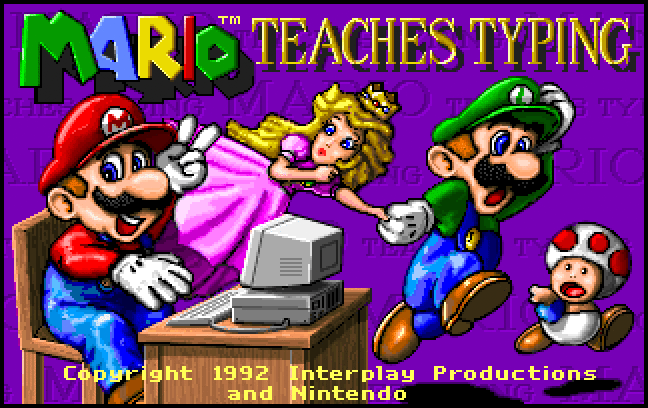Video games have been part of education since the beginning. When Spacewar! was developed in 1962 for the PDP-1 at the Massachusetts Institute of Technology (MIT), a new era of entertainment was born. In the 55 years since, countless educational games, the creation of Serious Games, and so much more has happened.
Growing up in the 1990s, I was bombarded with mounds of games, between Humongous Games, Nintendo edutainment titles, the Carmen Sandiego series, and so many more that it’d take a separate article just to list them alone. Additionally, if you can get through this article without getting the “Where in the World is Carmen Sandiego?” television show theme stuck in your head, you might not have lived through the 1990s yourself.
But, I digress. By that point, educational titles were in full supply and we were put on full blast. Students lined up at computers for these video games to learn from Reader Rabbit, Mavis Beacon, and Pajama Sam. The holy grail was getting to play The Oregon Trail, a game where players had to make it on the Oregon Trail itself, utilizing resources given, without dying. Looking back, it was a 20 year old educational game from 1974 that kids clamored to play even then.
Delve into the Past to Learn the Future!
History has shown games and “edutainment” titles even in 1967, with a software title named Logo Programming, which taught the programming language Logo as an early example of a serious game. The late 1970s and 1980s saw a boom of new titles due to the ease of use of the new Personal Computers, like the TRS-80 and Commodore 64. Though, Lemonade Stand is the seemingly sole heir to the popular 1970’s educational titles for the Apple II. Atari even got an early chance to jump in with Math Gran Prix in 1982.
Nintendo jumped onto the bandwagon, pushing their educational Mario-themed games. These commonly known titles included Mario Is Missing!, Mario’s Time Machine, Mario Paint, and Mario Teaches Typing. But, Nintendo started even before those with Donkey Kong Jr. Math(Japan 1983, North America 1986). In the modern era, Nintendo’s edutainment doesn’t seemingly focus on the concept like it used to. But, they do continue with games like the knock-out Brain Age. Unfortunately, this progression also includes tons of shovel-ware titles available for the Wii and 3DS/DS, but every so often a gem is discovered.
What’s the Future of Educational Games?
Education will only get more diverse as the years progress. With the uprising of “Serious Games” in the past decade, doctors can learn proper techniques and skills without needing a real corpse. Police officers are trained in problem solving skills, digitally. Organizations like the Serious Games Institute (SGI), focus on applied research into the thought process of Serious Games, providing courses and education on how to properly convey the development. Training and technique are gamified across multiple vocations.
Additionally, Virtual Reality is at an all-time high at the moment. Back in 2011, author Ernest Cline dreamed up a world of VR, in his novel “Ready Player One”. In a dystopian near-future, people prefer to live in the virtual world, even attending school in the aptly named OASIS. Where, this is a nearly complete science-fantasy, some truth can be found in it to hint at our future. With online and virtual schooling, professors and teachers are just an email or a webcam call away. As technology advances, so do the ideas. For instance, companies like Google and Microsoft look into their respective head-mounted displays for new ways to give entertainment, which often runs parallel with education.
Immersive VR Education is working on a platform called Engage, which brings Cline’s VR classroom closer to being a reality than ever before with fully interactive lecture halls. Virtual assets and tools can help presenters teach their lesson plans, draw on the white boards, and interact with students through their Engage avatars. Engage 0.2 can already be found on Steam, Vive, and the Oculus Store.
The advent of the 360-degree camera is playing a part in the process as well. Google Expeditions Pioneer Program lets students travel to far off lands they normally wouldn’t have visited, whereas Alchemy VR lets people dive into the sea and explore the Great Barrier Reef.
On-The-Go To Learn
Where full-on teacher replacement is not in the outlook very soon, there are so many possibilities to learn using games and gamification today. With more virtual realities on the horizon, one has to ask when the educational institutes will eventually go fully digital, or if they will at all. Or will the idea be simplified and streamlined even more?
But, not all of the future of education is in virtual worlds; some can simply be found right in the palm of one’s hand. Digital mobile education is as simple as learning a new language with a slew of gamified apps available, such as Duolingo, or helping math skills with apps like Photomath. Out are the days that students have to write notes with a pencil. Note-taking in the modern era is simplistic with apps like OneNote and Evernote. TED-Ed gives a platform for more than 250,000 teachers and public speakers to do what they love. Websites like Udemy offer a mobile app to allow education and training in whatever the heart is set on completely on the go.
My Avatar And I
Not all games in education is embedded within the technology. Sometimes, it can be in the unlikeliest of ways. For example, school shootings over the years have put people up-in-arms about video games whenever it turns out the suspect plays them. Several here in the USA have been reported on, but in 2002, Germany had a similar situation. The Erfurt school massacre left 16 people dead at the Gutenberg-Gymnasium and because the gunman was an avid fan of first person shooters (called “ego shooters” in Germany), parents rose up against video games for a time. Fifteen years later, the situation has shifted dramatically in favor of games.
In 2011, a computer gaming educational group from the University of Erfurt named “Spawnpoint” worked on a project with teenagers of all ages at the Gutenberg-Gymnasium called “My Avatar and I”. They let the students create digital avatars of their own personal identity, share screenshots, and discuss the appreciation and contribution of computer games into the modern culture. Aside from the creativity factor involved, the project helped students learn from gamification and have self-reflection on their own multimedia usage. The project won the 2011 Dieter Baacke Prize, an award given each year to educational, social, and cultural work.
Since then, Spawnpoint and the University’s Erfurt Gaming Group continue to help train teachers on how to utilize games in their curriculum. They are taught that classic educational games are considered “chocolate-covered broccoli”, which refers to the idea that it may be sweet on the outside, but the second kids see the green vegetable, they will reject it. Instead, AAA games are introduced to the students to keep them engaged and teach the relevant lesson involved. The group also holds public events and presentations to advocate games as a cultural asset.
To Clarify: We Must Gamify!
In conclusion, video games, gamification, and utilization of digital tech is the future of education, training, and culture itself. The quicker we, as society, embrace this concept, the sooner we can move forward to make education easier to those that want to learn.


